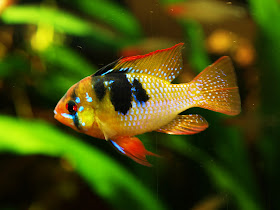
Mikrogeophagus ramirezi is a species of freshwater fish endemic to the Orinoco River basin, in the savannahs of Venezuela and Colombia in South America. The species is also called as Dwarf butterfly cichlid has been examined in studies on fish behaviour and is a popular aquarium fish, traded under a variety of common names including Ram, Blue ram, German blue ram, Asian ram, Butterfly cichlid, Ramirez's dwarf cichlid and Ramirezi. The species is a member of the family Cichlidae and is included in subfamily Geophaginae.
The Dwarf butterfly cichlid is a popular cichlid for the tropical freshwater, community aquarium although it is not necessarily the easiest cichlid to maintain in many situations. This is because the species is often kept with other fish that are more assertive, aggressive or overly active. The species is innately shy and is best kept with passive dither fish, such as neon or cardinal tetras. The species will readily exhibit breeding behaviours in water of pH 5.0-6.5, though softer water encourages more regular spawning. It is easier to maintain the species in larger aquaria as the species is intolerant of common aquarium pollutants such as nitrate.
The aquarium should be decorated to mimic the natural environment and is best decorated with several densely planted regions of aquatic plants, separated by open water. The Dwarf butterfly cichlid species is prone to filial cannibalism of its brood if distressed. As the water must be free of pollutants, aquarium filtration is important, though water movement should not be extreme. Removing and replacing small amounts of water changes assists with minimising the quantities of these pollutants and should be conducted regularly.
Numerous strains of Dwarf butterfly cichlid have been developed in Asia for the tropical aquarium fish hobby. These include numerous xanthistic forms, known as gold rams, along with larger, high-bodied and long-finned varieties. Many of these varieties suffer from lower fertility, health problems or reduced brood care in comparison to wild-type specimens.